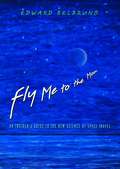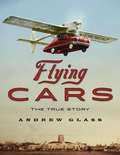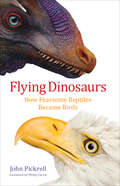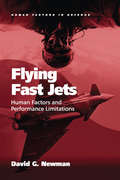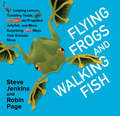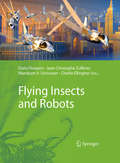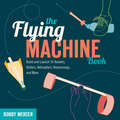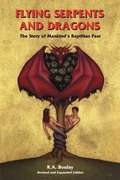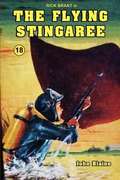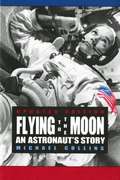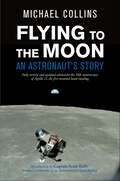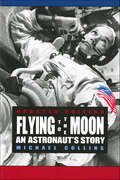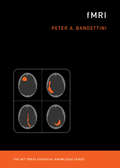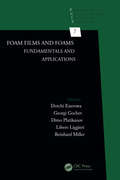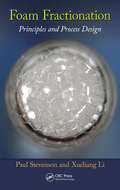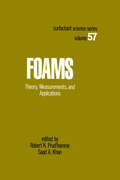- Table View
- List View
Fly Me to the Moon: An Insider's Guide to the New Science of Space Travel
by Edward BelbrunoWhen a leaf falls on a windy day, it drifts and tumbles, tossed every which way on the breeze. This is chaos in action. In Fly Me to the Moon, Edward Belbruno shows how to harness the same principle for low-fuel space travel--or, as he puts it, "surfing the gravitational field." Belbruno devised one of the most exciting concepts now being used in space flight, that of swinging through the cosmos on the subtle fluctuations of the planets' gravitational pulls. His idea was met with skepticism until 1991, when he used it to get a stray Japanese satellite back on course to the Moon. The successful rescue represented the first application of chaos to space travel and ushered in an emerging new field. Part memoir, part scientific adventure story, Fly Me to the Moon gives a gripping insider's account of that mission and of Belbruno's personal struggles with the science establishment. Along the way, Belbruno introduces readers to recent breathtaking advances in American space exploration. He discusses ways to capture and redirect asteroids; presents new research on the origin of the Moon; weighs in on discoveries like 2003 UB313 (now named Eris), a dwarf planet detected in the far outer reaches of our solar system--and much more. Grounded in Belbruno's own rigorous theoretical research but written for a general audience, Fly Me to the Moon is for anybody who has ever felt moved by the spirit of discovery.
The Fly Who Flew to Space
by Lauren SánchezFlynn is a little fly with big dreams. School isn’t easy for Flynn, and they daydream of becoming an astronaut. One day while exploring a nearby rocket company they stumble onto a rocket ship and into the biggest adventure of their life. <P><P> Young readers will be introduced to early space concepts such as atmosphere and G-Force while being introduced to Earth’s amazing natural wonders, all while being reminded that big dreams and a curious mind can lead to the most astonishing discoveries. <P><P> Emmy-award winning journalist, pilot and philanthropist Lauren Sanchez takes readers on a high-flying space adventure with Flynn the Fly in her picture book debut. Inspired by her childhood battle with dyslexia and a lifelong love of flying, The Fly Who Flew to Space will have little readers learning about early STEM concepts and reaching for the stars. <P><P><i>Advisory: Bookshare has learned that this book offers only partial accessibility. We have kept it in the collection because it is useful for some of our members. Benetech is actively working on projects to improve accessibility issues such as these.</i> <p> <b>New York Times Bestseller</b>
Flying Cars: The True Story
by Andrew GlassStories of inventors who have aimed for the sky: &“Start your engines and get ready to take off for an amazing read&” (Kirkus Reviews, starred review). Humans have always wanted to fly—and as soon as there were planes and cars, many people saw a combination of the two as the next step for personal transportation. Visionary engineers and inventors did their best to make the flying car a reality, not just an elusive dream. This book is a breezy account of hybrid vehicles and their creators, and of the intense drive that kept bringing inventors back to the drawing board despite repeated failures and the dictates of common sense. Illustrated with archival photos, this entertaining survey tells the stories of dreamers from Robert Fulton to Henry Ford to Buckminster Fuller, taking readers as far back as Icarus and forward into the present day—with a look toward the possibilities of the future as well. &“Readers learn about many intriguing airplane-car hybrids, such as the Airphibian, invented by Robert Fulton, who flew his vehicle at 110 miles per hour, landed it, single-handedly converted it into a car in under five minutes, then &‘drove the convertible proudly into Manhattan at a breezy 55 miles per hour.&’ These stories of invention are undeniably appealing. . . . Fascinating.&” —School Library Journal Includes illustrations, source notes, bibliography, and an index
Flying Dinosaurs: How Fearsome Reptiles Became Birds
by John PickrellThe discovery of stunning, feathered dinosaur fossils coming out of China since 2006 suggest that these creatures were much more bird-like than paleontologists previously imagined. Further evidence—bones, genetics, eggs, behavior, and more—has shown a seamless transition from fleet-footed carnivores to the ancestors of modern birds.Mixing colorful portraits with news on the latest fossil findings and interviews with leading paleontologists in the United States, China, Europe, and Australia, John Pickrell explains and details dinosaurs' development of flight. This special capacity introduced a whole new range of abilities for the animals and helped them survive a mass extinction, when thousands of other dinosaur species that once populated the Earth did not. Pickrell also turns his journalistic eye toward the stories behind the latest discoveries, investigating the role of the Chinese black market in trading fossils, the controversies among various dinosaur hunters, the interference of national governments intent on protecting scientific information, and the race to publish findings first that make this research such a dynamic area of science.
Flying Dinosaurs: How Fearsome Reptiles Became Birds
by John Pickrell&“It will be difficult for any reader to think about dinosaurs—or birds—in the same ways they had before.&”—Publishers Weekly The discovery of stunning, feathered dinosaur fossils coming out of China in the twentieth century suggests that these creatures were much more bird-like than paleontologists previously imagined. Further evidence—bones, genetics, eggs, behavior, and more—has shown a seamless transition from fleet-footed carnivores to the ancestors of modern birds. Mixing colorful portraits with news on the latest fossil findings and interviews with leading paleontologists in the United States, China, Europe, and Australia, John Pickrell explains and details dinosaurs&’ development of flight. This special capacity introduced a whole new range of abilities for the animals and helped them survive a mass extinction, when thousands of other dinosaur species that once populated Earth did not. Pickrell also turns his journalistic eye toward the stories behind the latest discoveries, investigating the role of the Chinese black market in trading fossils, the controversies among various dinosaur hunters, the interference of national governments intent on protecting scientific information, and the race to publish findings first that make this research such a dynamic area of science. &“Fascinating.&”
Flying Fast Jets: Human Factors and Performance Limitations (Human Factors in Defence)
by David G. NewmanThis book provides a detailed general overview of the human factors and performance limitations associated with flying fast jets, integrating all the latest available research literature on the demanding operational tasks faced by such pilots and aircrews. As such, it has a strong military focus, dealing with pilots of fighter aircraft, attack aircraft and lead-in fighter trainer aircraft that are traditionally only single or dual pilot operations. The book deals not only with the issue of G force, but discusses ejection and escape/survival, disorientation, high altitude physiology, pilot training and selection, helmet-mounted equipment, situational awareness, data fusion and multi-sensor integration, human machine interface issues and advanced cockpit design. It examines the human performance issues associated with the technological advances made in fast jets, such as increased manoeuvrability, increased use of the pilot’s head as a mounting platform for sensor and weapons systems, and the complexities involved in the human-machine interface within these aircraft.
Flying Frogs and Walking Fish: Leaping Lemurs, Tumbling Toads, Jet-Propelled Jellyfish, and More Surprising Ways That Animals Move
by Steve Jenkins Robin PageA red-lipped batfish waddles across the sea floor on its fins, searching for small sea creatures to eat. Other animals may fly or glide, or jet-propel themselves to get around. These creatures come equipped with legs, wings, or tentacles, and they often move from place to place in surprising ways. In the latest eye-catching escape into the kingdom of Animalia, Caldecott Honor-winning team Jenkins and Page show how animals roll, fly, walk, leap, climb, swim and even flip! This fascinating and fun illustrated nonfiction melds science, art, biology, and the environment together in a detailed and well-researched book about how animals move in our world today.
Flying Insects and Robots
by Jean-Christophe Zufferey Mandyam V. Srinivasan Dario Floreano Charlie EllingtonFlying insects are intelligent micromachines capable of exquisite maneuvers in unpredictable environments. Understanding these systems advances our knowledge of flight control, sensor suites, and unsteady aerodynamics, which is of crucial interest to engineers developing intelligent flying robots or micro air vehicles (MAVs). The insights we gain when synthesizing bioinspired systems can in turn benefit the fields of neurophysiology, ethology and zoology by providing real-life tests of the proposed models. This book was written by biologists and engineers leading the research in this crossdisciplinary field. It examines all aspects of the mechanics, technology and intelligence of insects and insectoids. After introductory-level overviews of flight control in insects, dedicated chapters focus on the development of autonomous flying systems using biological principles to sense their surroundings and autonomously navigate. A significant part of the book is dedicated to the mechanics and control of flapping wings both in insects and artificial systems. Finally hybrid locomotion, energy harvesting and manufacturing of small flying robots are covered. A particular feature of the book is the depth on realization topics such as control engineering, electronics, mechanics, optics, robotics and manufacturing. This book will be of interest to academic and industrial researchers engaged with theory and engineering in the domains of aerial robotics, artificial intelligence, and entomology.
The Flying Machine Book: Build and Launch 35 Rockets, Gliders, Helicopters, Boomerangs, and More (Science in Motion)
by Bobby MercerCalling all future Amelia Earharts and Chuck Yeagers--there's more than one way to get off the ground. Author and physics teacher Bobby Mercer will show readers 35 easy-to-build and fun-to-fly contraptions that can be used indoors or out. Better still, each of these rockets, gliders, boomerangs, launchers, and helicopters are constructed for little or no cost using recycled materials. The Flying Machine Book will show readers how to turn rubber bands, paper clips, straws, plastic bottles, and index cards into amazing, gravity-defying flyers. Learn how to turn a drinking straw, rubber band, and index card into a Straw Rocket, or convert a paper towel tube into a Grape Bazooka. Empty water bottles can be transformed into Plastic Zippers and Bottle Rockets, and ordinary paper can be cut and folded to make a Fingerrangs--a small boomerang--or a Maple Key Helicopter. Each project contains a material list and detailed step-by-step instructions with photos. Mercer also includes explanations of the science behind each flyer, including concepts such as lift, thrust, and drag, the Bernoulli effect, and more. Readers can use this information to modify and improve their flyers, or explain to their teachers why throwing a paper airplane is a mini science lesson. Bobby Mercer has been sharing the fun of free flight for over two decades as a high school physics teacher. He is the author of several books and lives with his family outside of Asheville, North Carolina.
The Flying Man: Otto Lilienthal, the World's First Pilot
by Mike DownsHere is the little-known history of Otto Lilienthal, a daring man whose more than 2,000 successful flights inspired the Wright Brothers and other aviation pioneers.In 1862, balloons were the only way to reach the sky. But 14-year-old Otto Lilienthal didn&’t want to fly in balloons. He wanted to soar like a bird. Scientists, teachers, and news reporters everywhere said flying was impossible. Otto and his brother Gustav desperately wanted to prove them wrong, so they made their own wings and tried to take flight. The brothers quickly crashed, but this was just the beginning for Otto, who would spend the next 30 years of his life sketching, re-sketching, and building gliders. Over time, Otto&’s flights got longer. His control got better. He learned the tricks and twists of the wind. His flights even began to draw crowds. By the time of his death at age 48, Otto had made more than 2,000 successful glider flights. He was the first person in history to spend this much time in the air, earning the title of the world&’s first pilot and paving the way for future aviation pioneers.
Flying Serpents and Dragons: The Story of Man's Reptilian Past
by R. A. BoulayWorld-wide legends refer to giant flying lizards and dragons which came to this planet and founded the ancient civilizations of Mesopotamia, Egypt, India and China. Who were these reptilian creatures? This book provides the answers to many of the riddles of history.
The Flying Stingaree (Rick Brant, # #18)
by John BlaineRick Brant and buddy Scotty are back for another science mystery. This time they are in a small houseboat on the Chesapeake Bay of Maryland, set to figure out flying stingrays. Published in 1963, there are references to now obsolete items.
Flying to the Moon: An Astronaut's Story
by Michael CollinsIn this entrancing account, space traveler Michael Collins recalls his early days as an Air Force test pilot, his astronaut training at NASA, and his unparalleled experiences in orbit, including the Apollo 11 mission, the first manned lunar landing. The final chapter to his autobiography, revised and updated for this edition, is an exciting and convincing argument in favor of mankind's continued exploration of our universe.
Flying to the Moon: An Astronaut's Story
by Michael CollinsBased on the adult bestseller Carrying the FireIn time for the 50th anniversary of man's first landing on the moon, this re-release of Michael Collins's autobiography is a bold, sparkling testament to exploration and perseverance. In this captivating account, space traveler Collins recalls his early days as an Air Force test pilot, his training at NASA, and his unparalleled experiences in orbit, including the Apollo 11 mission, the first manned lunar landing. The final chapter to this autobiography is an exciting and convincing argument in favor of mankind's continued exploration of our universe. Originally published in 1976 and updated for this new edition, including an introduction from astronaut Scott Kelly, Collins's voice and message are sure to resonate with a new generation of readers.
Flying to the Moon: An Astronaut's Story
by Michael CollinsIn this entrancing account, space traveler Michael Collins recalls his early days as an Air Force test pilot, his astronaut training at NASA, and his unparalleled experiences in orbit, including the Apollo 11 mission, the first manned lunar landing. The final chapter to his autobiography, revised and updated for this edition of Flying to the Moon, is an exciting and convincing argument in favor of mankind's continued exploration of our universe. "Several astronauts have written about their experiences, but none so well as Michael Collins...This is just the book to give the child whose parents made Yeager and The Right Stuff best sellers."-The Washington Post Book World
fMRI (The MIT Press Essential Knowledge Series)
by Peter A. BandettiniAn accessible introduction to the history, fundamental concepts, challenges, and controversies of the fMRI by one of the pioneers in the field. The discovery of functional MRI (fMRI) methodology in 1991 was a breakthrough in neuroscience research. This non-invasive, relatively high-speed, and high sensitivity method of mapping human brain activity enabled observation of subtle localized changes in blood flow associated with brain activity. Thousands of scientists around the world have not only embraced fMRI as a new and powerful method that complemented their ongoing studies but have also gone on to redirect their research around this revolutionary technique. This volume in the MIT Press Essential Knowledge series offers an accessible introduction to the history, fundamental concepts, challenges, and controversies of fMRI, written by one of the pioneers in the field. Peter Bandettini covers the essentials of fMRI, providing insight and perspective from his nearly three decades of research. He describes other brain imaging and assessment methods; the sources of fMRI contrasts; the basic methodology, from hardware to pulse sequences; brain activation experiment design strategies; and data and image processing. A unique, standalone chapter addresses major controversies in the field, outlining twenty-six challenges that have helped shape fMRI research. Finally, Bandettini lays out the four essential pillars of fMRI: technology, methodology, interpretation, and applications. The book can serve as a guide for the curious nonexpert and a reference for both veteran and novice fMRI scientists.
fMRI Techniques and Protocols (Neuromethods #220)
by Massimo FilippiThis third edition volume expands on the previous edition with updates on the latest methodological aspects of fMRI and achievements made through the applications to the study of central nervous system functioning in the clinical field. The chapters in the book are organized in four parts: Part One talks about the basic knowledge for the understanding of the technical aspects of fMRI. Part Two describes the main findings obtained from the application of fMRI to study brain system function of healthy individuals. Part Three explores clinical findings obtained from the use of fMRI to assess the role of brain plasticity in major neurological and psychiatric conditions. Part Four presents novel approaches for the integration of fMRI data with measures of damage assessed using structural MR techniques and the use of fMRI to image spinal cord function. In the Neuromethods series style, chapters include the kind of detail and key advice from the specialists needed to get successful results in your laboratory.Cutting-edge and comprehensive, fMRI Techniques and Protocols, Third Edition provides clinicians and researchers with a &“user-friendly&” summary of the field, and helps them plan and carry out successful studies.
FND Stories: Personal and Professional Experiences of Functional Neurological Disorder
by Gregg H. Rawlings, Markus Reuber, Jon Stone and Maxanne McCormickFunctional Neurological Disorder (FND) is one of the most common diagnoses among patients referred to neurology clinics, but is still misunderstood and under-recognised by medical professionals and the public. This vital book brings together the voices of healthcare professionals and people living with FND across the world. Experts in neurology provide a clear, evidence-based explanation of FND as an introduction, laying the foundation for the personal stories of people with FND and the professionals involved in their care. From testing and diagnosis to dealing with stigma and coping with changing symptoms, each chapter delves into the realities of life with FND from the perspective of lived experience. FND can be an isolating condition. The life stories in this book will help you to make sense of living with FND and tackle its challenges alongside others with the condition.
Foam Engineering
by Paul StevensonContaining contributions from leading academic and industrial researchers, this book provides a much needed update of foam science research. The first section of the book presents an accessible summary of the theory and fundamentals of foams. This includes chapters on morphology, drainage, Ostwald ripening, coalescence, rheology, and pneumatic foams.The second section demonstrates how this theory is used in a wide range of industrial applications, including foam fractionation, froth flotation and foam mitigation. It includes chapters on suprafroths, flotation of oil sands, foams in enhancing petroleum recovery, Gas-liquid Mass Transfer in foam, foams in glass manufacturing, fire-fighting foam technology and consumer product foams.Key features:Foam fractionation is an exciting and emerging technology, starting to gain significant attentionDiscusses a vital topic for many industries, especially mineral processing, petroleum engineering, bioengineering, consumer products and food sectorLinks foam science theory to industrial applications, making it accessible to an engineering science audienceSummarizes the latest developments in this rapidly progressing area of researchContains contributions from leading international researchers from academia and industry
Foam Films and Foams: Fundamentals and Applications (Progress in Colloid and Interface Science)
by Dotchi Exerowa, Georgi Gochev, Dimo Platikanov, Libero Liggieri and Reinhard MillerThis book describes in detail the scientific philosophy of the formation and stabilization-destabilization of foams. It presents all hierarchical steps of a foam, starting from the properties of adsorption layers formed by foaming agents, discussing the properties of foam films as the building blocks of a foam, and then describing details of real foams, including many fields of application. The information presented in the book is useful to people working on the formulation of foams or attempting to avoid or destruct foams in unwanted situations.
Foam Fractionation: Principles and Process Design
by Paul Stevenson Xueliang LiFoam fractionation is a separation process in which proteins and other amphipathic species adsorb to the surface of bubbles. The bubbles are then removed from the solution in the form of foam at the top of a column. Due to its cost-effectiveness, foam fractionation has the potential for rapid commercial growth, especially in biotechnology.To assist
Foams: Theory: Measurements: Applications
by RobertK. Prud'hommeThis volume discusses the physics and physical processes of foam and foaming. It delineates various measurement techniques for characterizing foams and foam properties as well as the chemistry and application of foams. The use of foams in the textile industry, personal care products, enhanced oil recovery, firefighting and mineral floatation are highlighted, and the connection between the microstructure and physical properties of foam are detailed. Coverage includes nonaqueous foams and silicone antifoams, and more.
Focus on California Earth Science
by PearsonTextbook for California schoolchildren on earth systems and processes, plate tectonics and earth's structure, weather and climate, and ecology and resources.
Focus on Earth Science: Reading and Note Taking Guide Level B (California Edition)
by Pearson EducationThis Reading and Note Taking Guide helps your students succeed in their study of science. Working through the exercises will help them understand and organize the concepts presented in the textbook. The completed worksheets then become easy-to-follow study guides for test preparation. It also helps students improve their study and reading skills.
Focus on Earth Science: Reading and Note Taking Guide, Level A (California Edition)
by Pearson EducationThis Reading and Note Taking Guide helps your students succeed in their study of science. Working through the exercises will help them understand and organize the concepts presented in the textbook.
